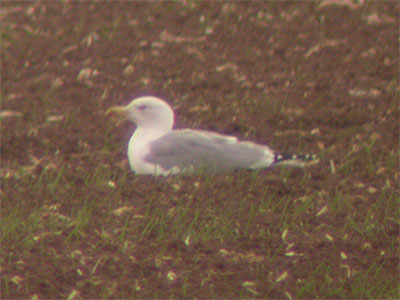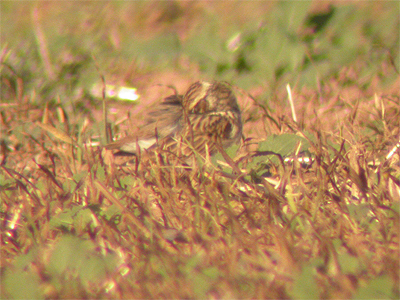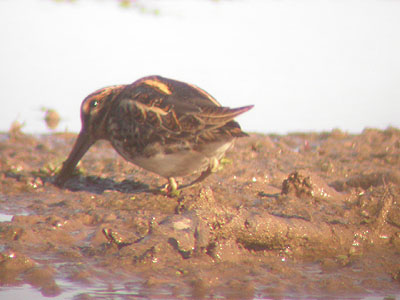

| Eakring Bird news | ||
| October 2003 | ||
| Featuring news and sightings from Eakring | ||
| October
1st |
|
| The Greenshank was at Eakring Flash early afternoon, with a Common Buzzard over there. At least 400 Golden Plover were in fields at Church Hill. | |
| October
2nd |
|
| The long-staying Greenshank remains at Eakring Flash with three Snipe there. Small numbers of migrants were passing south-east including 16 Swallows. Two Common Buzzards were around Eakring Meadows late afternoon. | |
| October
4th |
|
| Still quiet, but 128 Pink-footed Geese flew south-east at 08:47am and a Peregrine was hunting Golden Plover adjacent to Eakring Flash. Two Common Buzzards were roaming the Red Hill area mid-morning. Small flocks of Lesser Redpoll in the area today, included eight at Eakring Flash and 10 around Red Hill, whilst small numbers of Siskin moved through. Three Jays moved low south-west through Eakring Flash. | |
| October
5th |
|
| A Leach's
Storm-petrel went south-west this morning.
Observed near Eakring Flash, the bird was initially noted
quite high and seemingly coming in from a north-easterly
direction. It flew low over two observers and appeared to
very nearly come down in a nearby field near Eakring
village, when harrassed by a Rook. Although it was not
seen to actually leave the area, a thorough search of all
fields and nearby waters revealed no sign. This obviously
represents a new species for the area and the second
sea-bird of the year, following the Arctic Skua in
August. Congratulations must go to the bird's finders
Robin Brace and Tony Wardell, gaining just reward for
their many hours coverage throughout the past year. Other news on another otherwise very quiet morning, concerned 48 Pink-footed Geese north-east and 23 Redwing south-west. Eakring Flash held 35 Teal early morning. The first argentatus Herring Gulls of the year were three flying high south-west. |
|
| October
9th |
|
| A very
high Autumn count of Golden Plover was made this morning,
with 918 in fields around Church Hill. The same fields
also held good numbers of both Sky Lark and Linnet,
though the highest numbers of Linnets were recorded
during some early morning movements, when several groups
totalled 44 south. Other species moving through included
small numbers of all the commoner finches (amongst which
were three Brambling) Three Swallow and
38 Skylark went south-west and 14 Reed Bunting south-west
was a high area visible migration count. A movement of Pink-footed Geese consisted of five seperate skiens, with a combined total of 401 birds. All were going east and came between 9:00 and 10:55am. A Water Rail was at the southern-end of Eakring Flash, from where two of the three Chiffchaffs in the area today were present. |
|
| October
10th |
|
| A Shoveler was one of only five ducks on Eakring Flash this afternoon, also Chiffchaff there. | |
| October
11th |
| Two Yellow-legged Gulls
were in fields with numbers of Lesser Black-backed Gulls
this morning - at first near Eakring Flash, then
relocating to fields along the Kneesall Road. 80 Pink-footed Geese went south-east (per Robin Brace and Tony Wardell) |
 |
| October
12th |
|
| 80 Pink-footed Geese went north-west over Penny Pasture Common this morning, with migrant thrushes including 15 Fieldfare and five Redwing south (per Robin Brace and Tony Wardell) | |
| October
13th |
|
| Adult Yellow-legged
Gull at Eakring Flash late morning, in with good
numbers of Lesser Black-backed Gulls. Visible migration saw thrushes moving through. Most flocks were very high and totals included 339 Fieldfare, 169 Redwing and 50 Starling south-west. 19 Brambling went north and 64 Lapwing flew high west in several groups. The area held good numbers of Sky Larks at most sites and two Chiffchaff were in the Sallows at Eakring Flash. |
|
| October
16th |
|
| Rather
quiet for long periods this morning, although the adult Yellow-legged
Gull was again in fields at Eakring Flash, with
the Water Rail seen again. Unusual flyover records came from both Nuthatch and Corn Bunting. More usual however, were small numbers of Fieldfare (160 south) and Redwing (14 south) over. Skylarks were moving (mostly south-east) and a total of 65 included many seen to fly high out of fields before moving off in various-sized groups. Plenty of Blackbirds also in the area, including four south-west and four Song Thrush south and south-west. A Brambling flew over the Church Hill area, where at least 800 Golden Plovers were present. These birds continue to be very mobile and commute between both Church Hill and Eakring Flash, but also fly off towards Bilsthorpe. |
|
| October
18th |
|
| Despite a
run of easterly winds and being mid-October, the area is
still quiet. Even what's normally the busiest time of
year for visible migration remains unusually poor. Many
species are moving through, but not in the decisive
manner so often recorded. Small numbers of thrushes such
as Fieldfare and Redwing were heading in two general
directions today, with birds passing high south-west and
generally low north and north-west. Groups moving in the
latter direction are probably relocating birds, moving
north after a coastal arrival well south of a line east
of Nottinghamshire to the coast. Brambling are now passing through daily, today three went south-west. The Water Rail was still at Eakring Flash with at least three Snipe and a Grey Wagtail there. a Common Buzzard was at Lound Wood and three Mandarin flew down The Beck and over Eakring Meadows. |
|
| October
19th |
|
| Adult
female Peregrine in the area early
morning, with nine Wigeon at Eakring Flash briefly.
Regular disturbance and shooting at Eakring Flash are
ensuring that wildfowl numbers are at a minimum. Some migration this morning with small numbers of all the expected species. 151 Fieldfare went west, including a group of 25 that were so high up, that they were only detected whilst watching one of 10 Herring Gull south today. 63 also went through north and north-east. Small numbers of Black-headed and Common Gull were moving through. Eakring Flash continued to hold single Chiffchaff and Water Rail, with 12 Teal dropping in there late morning. |
|
| October
20th |
|
| 21 Teal at Eakring Flash late morning, with a Chiffchaff still along the old hedge. | |
| October
22nd |
|
| A count of the Golden Plover flock revealed that a minimum of 434 were in the Church Hill area. This count is much higher than that of the last few days when numbers had dropped from the record counts of earlier in the month. | |
| October
23rd |
|
| Still incredibly quiet again. The Water Rail was along The Beck, at the end of the old hedge and 22 Teal were at the southern-end of Eakring Flash. The small Lesser Redpoll flock here had increased to 20 birds, with part of this group flying off and leaving just eight by mid-morning. 283 Starling flew west, but other visible migration was today virtually undetectable amid the regular commuting birds in the area. There was an increase in the Common Gull numbers today, with birds also noted flying high south-west, along with small numbers of Herring Gulls. A Common Buzzard was again in the Lound Wood area. | |
| October
26th |
|
| October
suddenly and rather unexpectedly sprung to life today and
a mid-morning visit to Eakring Flash produced Wood Lark,
Water Rail, Jack Snipe and a female Common Crossbill
briefly. Representing only the fourth Wood Lark record here, a single bird was found in fields adjacent to Eakring Flash (above left) It showed well throughout and was still present when I left the area. All the area's previous records had come within the period September 30-October 11th, this now being the latest record here. Another surprise was the Common Crossbill, which came in from the north-west before heading off north after briefly landing for a drink at the southern-end. This is the first record of Common Crossbill since 2001 and comes despite no apparent influx of the species elsewhere into the UK this year. Around Eakring Flash itself, the Water Rail was along the western-side and a Jack Snipe fed out in the open at the southern-end and afforded good views initially, before flying into cover. At Eakring Meadows, a large Fieldfare flock numbered at least 450 birds and around 200 Golden Plover were in their favoured locality of Church Hill. |
 |
 |
| October
27th |
|
| 298 Pink-footed
Geese flew north-west over the area mid-morning.
Visible migration again remained very limited but signs were there with 34 Skylark and 154 Fieldfare moving south-west. A conservative estimate of at least 80 Meadow Pipits were in fields around Eakring Flash and the Wood Lark was probably still present nearby and possibly heard to call once, but was not in the same field as yesterday. |
|
| October
28th |
|
| A Merlin
was the highlight of the morning, flying west over
Eakring Flash early am, with a drake Goosander later
flying high north-west. A slight improvement regarding
visible migration today, with 535 Starling through west. Of interest were the four Bullfinch (two males and two females) present briefly at Eakring Flash along the old hedge, before flying off west over Red Hill. An hour later, another female arrived in from the north-east. Bullfinch are very rarely recorded here (only twice since 1998) actively flying over open countryside and I have never observed them during visible migration watches conducted at other sites, flying through in the manner associated with most finches. The Water Rail was again calling this morning, along the western-side of Eakring Flash. |